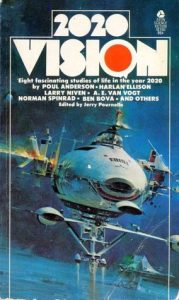 2020 Vision
2020 Vision
Jerry Pournelle, ed.
This anthology was first published in 1974. That’s the original cover over there on the right. I found a copy of the 1980 edition (the cover isn’t nearly as good) at the Friends of the Library sale last month and thought it would be fun to see what science fiction writers in the 1970s thought this next year would be like. In some ways, they missed the boat by a mile. In others, they almost nailed it.
The 1980 edition has a few additional editorial comments by Pournelle, but otherwise the two different editions are the same.“Build Me a Mountain” by Ben Bova. Other than some hippy types, this story could pretty much be one that was written today as contemporary mainstream fiction. Part of the Kinsman series, it gives a future where the space program is being systematically shut down by politicians and bureaucrats. One of the best in the book. I bought the Kinsmen series in ebook after reading this one.
“Cloak of Anarchy” by Larry Niven. Set early in Niven’s Known Space series, it’s about a world where personal cars no longer exist. The freeways have been turned into Anarchy Parks. Anything goes except violence. That rule is i=enforced by floating spheres which will render a shock that will knock violators unconscious. At least until someone figures out a way to knock all of the spheres out at once. I read this one in high school, and it has held up well to what I remembered about it. Probably my favorite in the book.
“Silent in Gehenna” by Harlan Ellison. I read this one some years ago, although I couldn’t say when. I also didn’t remember much about it. Ellison gives us a future US that is controlled by fascists before jumping into some weird alien world.
“The Pugilist” by Poul Anderson. In contrast to Ellison, Anderson shows us a future US that is communist and a satellite of the Soviet Union. I’ve read a lot of Anderson, but this story was new to me. I could see some parallels between this future and the one we actually ended up in. (That is not a good thing.) And the final line is a doozy. My favorite after the Niven and Bova.
“Eat, Drink, and Be Merry” by Dian Girad. I had not heard of Ms. Girad before. Her story is about a woman living in a world where everyone’s weight is monitored, and their calorie intake is controlled by a central computer. Another where I could see some parallels with today. NYC’s ban on large sodas, anyone?
“Prognosis: Terminal” by David McDaniel. McDaniel is another author I’d not hear of. Pournelle’s story notes indicate the author had passed away by the time the second edition. The ISFDB shows he only wrote a handful of stories. This one was a bit of a slog, but McDaniel came the closest in depicting the internet, cell phones, and terminals everywhere.
“Future Perfect” by A. E. Van Vogt. This isn’t Van Vogt at his best, but it’s certainly better than some of his stuff I’ve read. It was a bit hard to follow at times, but the main idea came through. It concerns one man’s rebellion against a society in which your mate is chosen for you by computer.
“A Thing of Beauty” by Norman Spinrad. In this future, Japan is the dominant world power. The US is selling its monuments and landmarks for cash. A wealthy Japanese business man wants to buy something to impress his wife’s parents so they will get off his back. That’s all I can say without spoiling the ending. This one is something of a joke, but Spinrad pulls it off with panache. It had been years since I had read Spinrad. I saw that a couple of his collections were available in ebook form on the cheap, so I snagged them.
2020 Vision was a fun and enjoyable read, even if most of the futures presented would be considered a dystopia to a greater or lesser degree. Other than Niven’s, I’m not sure I would want to live in any of them, and there are some I definitely wouldn’t want to live in.
